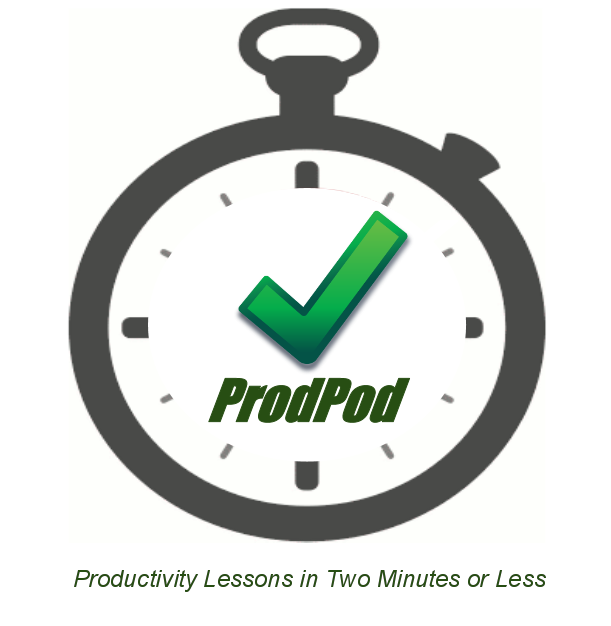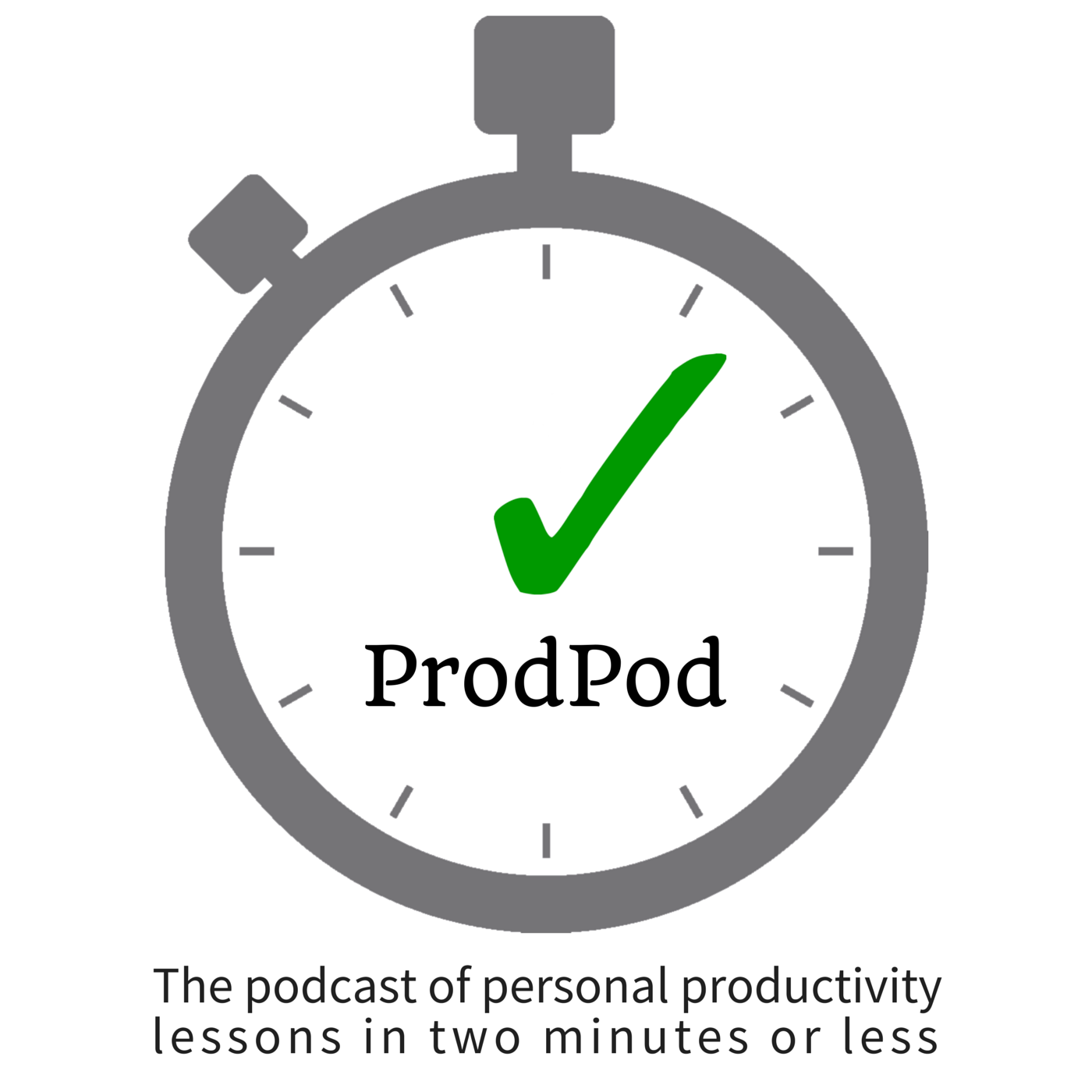Episodes

Thursday Mar 14, 2013
ProdPod: Episode 58 -- Paperless 2013
Thursday Mar 14, 2013
Thursday Mar 14, 2013
Google and several other companies have recently convened the Paperless Coalition [http://paperless2013.org] to help you "take the paper out of 'paperwork!'" In this episode, learn about the Paperless 2013 and go paperless in 2013!
According to their website:
Why should you go paperless?
If you do the quick math, that's conservatively two billion sheets of paper used every year just in the United States! We know better and we can do better...and the benefits are great for us...greater efficiency and higher productivity at work and at work.
It just takes small decisions and workflow changes. Using tools like Google Drive, HelloSign, and Nitro (which is a PDF creation tool) changes the print and paper chase of working to seamlessly collaborating and sharing documents and file without a single fiber of tree having to be used.
On the flip side, the companies like Lemon Digital Wallet, ShoeBoxed.com and Fujitsu's ScanSnap help you turn paper into digital files so that you can defeat the paper monster once and for all. The efficiences that can be found by having all your documents in one central, digital repository (even if you do keep the physical paper around for tax, legal, financial or other logical safekeeping).
While not a Paperless Coalition member, I am a big fan of Evernote and use that to capture my paper notebook pages after I go to a meeting so that even though I like the kinesthetic benefits of handwriting notes, I can still go paperless quickly and easily. With the Google Drive smartphone application, you can snap a photo and upload it directly to a Notebook folder as well.
You can find them at paperless2013.org where you can sign up for their monthly e-newsletter with tips and tools. I hope this sparks your interest in going paperless and gets you started toward a Paperless 2013.
According to the US Environmental Protection Agency, the average US office worker uses 10,000 sheets of copy paper each year. In 2010, the amount of paper recovered for recycling averaged 334 pounds for each person living in the US, according to the American Forest & Paper Association.

Tuesday Mar 12, 2013
ProdPod: Episode 57 -- Banish New Year's Resolutions!
Tuesday Mar 12, 2013
Tuesday Mar 12, 2013
This is about the time of year (end of February, beginning of March) when you realize that your New Year's resolution/s aren't going to happen, or you've forgotten that you've actually made them. So, in this episode, I offer a solution: banish making New Year's resolutions! Here's how....
Every time you don't make a NYR happen, you feel like a failure or worse, you don't remember you made the NYR. Why is this bad, you say? Either way--whether you feel negative emotions or you're numb to your own planning--your brain remembers it all. These brain pathways (that is, physical brain matter) mitigate future growth by stopping you from planning in the first place. It equates planning with pain and your brain's flight-or-fight response thinks it knows better so it helps you avoid activities that promote pain...even if "no pain, no gain" sometimes unlocks great potential. Or, your brain says, heck, you don't do the stuff you plan to do so why waste energy on these brain functions! At the end of the day, you get the short end of your own gray matter.
So, what should you do instead of NYRs? Here's what I've done for the past decade and while I haven't achieved a single NYR (because I haven't made one), I have achieved every goal I've set out to accomplish.
First, I chose a non-calendar end of my year. I chose my year-end to be October 31 and my "planning year" to start on November 1. November happens to be a significant time of year for me, my birth month, while it's also an arbitrary time of year for most people. I like November because it's before the major holidays (Thanksgiving and the winter holidays season) and yet it still gives me time to end the calendar year strong. So, during the month of October, I choose a number of goals for my upcoming year, by my life planning categories and by month. I try to focus on one life category per month through my year, then breaking down each goal into monthly activities and weekly activities and then daily activities. Monthly and weekly activities are usually planning and reviewing activities, while daily activities are usually the small, habitual tasks toward achieving that specific goal.
In all, make goals year-round and add activities toward those goals into your daily life.

Friday Feb 22, 2013
ProdPod: Episode 56 -- Software Overview: Remember The Milk
Friday Feb 22, 2013
Friday Feb 22, 2013
Here's a quick overview of the amazing capabilities of my personal productivity software, Remember The Milk. What's your favorite personal productivity software? Let me know in the comments, contact form or via email!

Wednesday Feb 20, 2013
ProdPod: Episode 55 -- The Purpose of Your Productivity System
Wednesday Feb 20, 2013
Wednesday Feb 20, 2013
In this episode, I define "personal productivity system." How do you define your personal productivity system? I'd love to hear from you in the comments or via email.
There was a time when I started first studying psychology and its relationship to my personal productivity when I thought my "productivity system" meant automation. Boy, was I sadly mistaken! It took me a long time (18 months to be exact) to figure out that my productivity system wasn't all about automating my life. It turns out that DOING was a huge part of my productivity system, and *I* had to do the DOING. What a shock to my system this was when I spent all that time setting up this amazing system and planning all day! Nothing got done! So, what is the purpose of your productivity system? I've come to define the purpose of a personal productivity system as a way to facilitate you DOING more consistently and better and KNOWING what you're not able to DO at any given time so you can relax and focus on what it is you can do.
Let me dive into this a little further so I explain this correctly.
The first part of that definition is that your personal productivity system is about doing more and better when you're able to. Doing more means, that by planning out the most efficient ways to get from A to B for any given task or project, you're able to get more done in a focused period of time. This isn't something you can do consistently without a system; believe me, for years, I tried! Next up is the adjective "better." What I mean is, that your productivity system should have a way for you to track what you've done and review what has been done to create as accurate a historical record as possible. Therefore you can match or increase your output sustainably from there. Again, no system equates to not only allowing in subjectivity about "better" but also about using potentially your fuzzy memory to recollect what you accomplished, or didn't. What does better look like for you?
Finally, one of the great, rarely spoken truths about personal productivity is the fact that you can't do more of anything without doing less of something right now. Your productivity system needs to be able to help you track when you can do things and when you cannot. Do you know what you can't do right now so you can start doing the one thing now that you can? If so, you likely have a system. If you don't, now you know why you need a system, and what a system really is.
How do you define "personal productivity system?" I'd love to hear from you in the comments or via email.

Thursday Feb 14, 2013
ProdPod: Episode 54 -- "Pull Method" for More Productive Relationships, Part Two
Thursday Feb 14, 2013
Thursday Feb 14, 2013
In the last episode, I discuss why I developed a "pull method" for more productive relationships along with the first phase. In this episode, I'll cover the next two phases.
2. Now that you have your relationships list, go down the list and mark each person with symbols representing whether you feel good or not when they come into mind. I use + or - signs, or :-) :-| or :-( , for my symbols. Not good includes however you define it but typically encompasses for me annoyance, frustration, indifference and dislike. Follow that exercise with placing an asterisk next to contacts with whom you must have a relationship. Perhaps I'll explain my thoughts on how I perform this data collection and analyze this data on a more granular level in a future episode. Some thoughts to ponder: what is the ratio of must relationships to positive symbol ones? Are there more not-good than feel-good contacts on your list? Does the happiness of the people you listed correlate to your relative happiness in life?
3. Moving onto the final phase of the pull method, take your list and filter to two new lists: one for your feel-good's and one for your not-good but must-have relationships. Now, for your feel-good's, plan ways in which you can see those people more (yes, in real life), deepen your relationships and generally show your appreciation for having them in your life...ergo, pull them closer to you! For the must-have's, put together a plan to increase positive interactions and carefully but steadily address the aspects of these relationships that make it not-good. Remember, some of these things that you don't like in your must-have relationships are likely present in your feel-good relationships as well; I'd start with confronting the issues in the not-good must-have relationships before backtracking to those of the feel-good's.
There you have it! The pull method for more productive relationships.

